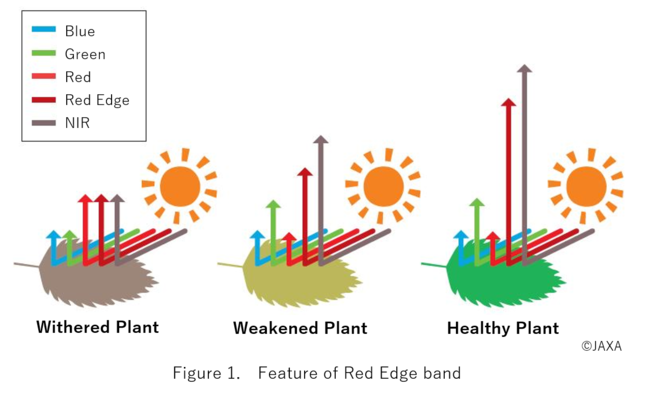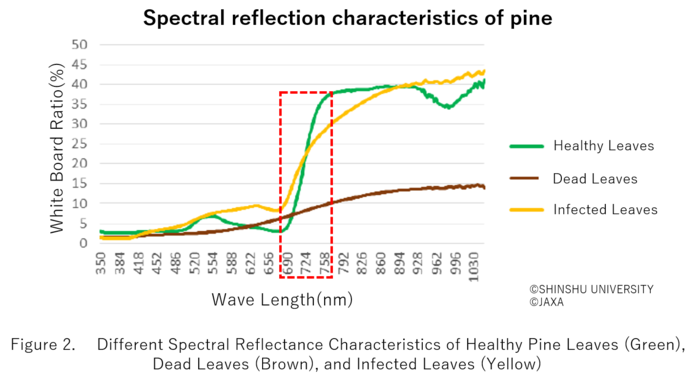- Other
- Other
- Other information
Research case studies
Extraction of pine beetle damaged* trees by utilizing Red Edge band
ALOS-3, an Advanced Optical Satellite developed by JAXA and expected launching before March 2023, is equipped with Red Edge and Coastal bands in addition to the same Red, Green, Blue, and NIR bands as its predecessor, ALOS. The Red Edge band, which is suitable for grasping the vegetation health, is expected to be utilized to grasp the situation of wide areas in the field of forestry.
Professor Masato Kato of Shinshu University, with his research achievements to utilize optical satellites in forestry and as an intellectual property inventor, conducted a JAXA-commissioned work in FY 2017 on the topic of "Evaluation of Usefulness of Advanced Land Optical Satellite in Forestry".
This article is part of the verification results of pine beetle damage classification using the Red Edge band, conducted by Professor Kato in FY 2017 to evaluate the effectiveness in forestry for the usages of ALOS-3.
*Pine beetle damage: Pine beetle, a Monochamus nematode about 1mm in length, enters the pine tree's body, preventing the tree from absorbing water. This causes the tree to die. The long horned beetle called Monochamus carries this nematode from one pine tree to another. From May to July, pine wood nematodes carried by pine spotted beetles invade pine trees, and the phenomenon of pine wilt begins to appear around autumn.
Interviewee:
 The Red Edge to NIR wavelength bands have strong spectral reflection characteristics from healthy plants and are useful for grasping the distribution of vegetation and their health condition.
The figure below shows how the spectral reflections depend on the plant health.
The Red Edge to NIR wavelength bands have strong spectral reflection characteristics from healthy plants and are useful for grasping the distribution of vegetation and their health condition.
The figure below shows how the spectral reflections depend on the plant health.
 As an example, the leaves of healthy, infected and dead trees were collected, their spectrum measurements were conducted, and the spectral reflection characteristics were examined. The following shows the results.
As an example, the leaves of healthy, infected and dead trees were collected, their spectrum measurements were conducted, and the spectral reflection characteristics were examined. The following shows the results.
 As shown in Figure 2, it can be observed that there is a large difference in spectral reflectance between healthy leaves, infected and dead leaves around 690 nm to 760 nm, which is the wavelength of the Red Edge band.
By taking advantage of this characteristic, the researchers conducted a study to classify healthy trees, infected trees, and dead trees about the damage caused by pine beetles by utilizing the satellite data.
As shown in Figure 2, it can be observed that there is a large difference in spectral reflectance between healthy leaves, infected and dead leaves around 690 nm to 760 nm, which is the wavelength of the Red Edge band.
By taking advantage of this characteristic, the researchers conducted a study to classify healthy trees, infected trees, and dead trees about the damage caused by pine beetles by utilizing the satellite data.
 This methodology can classify the damage category of red pine beetles by using differences in spectral reflectance from the trees. By analyzing simulated satellite images of the spatial resolution of ALOS-3, a map of pine beetle damage classification (healthy trees, infected trees and dead trees) was created.
In addition, although not shown in the results of this analysis, DCHM** created from the difference between DSM and DTM of airborne LiDAR data can be used to extract tree canopy in a wide area and with high precision, and to semi-automatically calculate tree location and number, crown area, diameter at breast height, and volume in a single tree with high precision. Furthermore, temporal changes can also be captured by comparing with aerial and satellite images acquired at different times.
【Example of analysis results (comparison of classification accuracy when using different number of bands)】
Regarding the observation bands mounted on ALOS-3, the accuracy for the utilization of the Blue, Green, Red, and NIR bands (ALOS equivalent) were compared, as well as using the Red Edge and Coastal bands in addition to those bands.
Comparison and validation were performed for each of the following bands at the multispectral (MS) spatial resolution (3.2m) equivalent to ALOS-3.
① Blue, Green, Red, NIR 4 bands
② Blue, Green, Red, NIR, Red Edge 5 bands
③ Blue, Green, Red, NIR, Coastal, Red Edge 6 bands
The accuracy of the detection results for each band is as follows.
This methodology can classify the damage category of red pine beetles by using differences in spectral reflectance from the trees. By analyzing simulated satellite images of the spatial resolution of ALOS-3, a map of pine beetle damage classification (healthy trees, infected trees and dead trees) was created.
In addition, although not shown in the results of this analysis, DCHM** created from the difference between DSM and DTM of airborne LiDAR data can be used to extract tree canopy in a wide area and with high precision, and to semi-automatically calculate tree location and number, crown area, diameter at breast height, and volume in a single tree with high precision. Furthermore, temporal changes can also be captured by comparing with aerial and satellite images acquired at different times.
【Example of analysis results (comparison of classification accuracy when using different number of bands)】
Regarding the observation bands mounted on ALOS-3, the accuracy for the utilization of the Blue, Green, Red, and NIR bands (ALOS equivalent) were compared, as well as using the Red Edge and Coastal bands in addition to those bands.
Comparison and validation were performed for each of the following bands at the multispectral (MS) spatial resolution (3.2m) equivalent to ALOS-3.
① Blue, Green, Red, NIR 4 bands
② Blue, Green, Red, NIR, Red Edge 5 bands
③ Blue, Green, Red, NIR, Coastal, Red Edge 6 bands
The accuracy of the detection results for each band is as follows.
① Blue, Green, Red, NIR 4 bands → 93.0%
② Blue, Green, Red, NIR, Red Edge 5 bands → 94.0%
③ Blue, Green, Red, NIR, Coastal, Red Edge 6 bands → 94.5%
By increasing the number of channels available for analysis, the accuracy of the analysis has gradually improved.
Characteristics of onboard bands and Red Edge band of ALOS-3
The onboard bands and wavelengths of ALOS-3 are as follows. The Red Edge to NIR wavelength bands have strong spectral reflection characteristics from healthy plants and are useful for grasping the distribution of vegetation and their health condition.
The figure below shows how the spectral reflections depend on the plant health.
The Red Edge to NIR wavelength bands have strong spectral reflection characteristics from healthy plants and are useful for grasping the distribution of vegetation and their health condition.
The figure below shows how the spectral reflections depend on the plant health.
 As an example, the leaves of healthy, infected and dead trees were collected, their spectrum measurements were conducted, and the spectral reflection characteristics were examined. The following shows the results.
As an example, the leaves of healthy, infected and dead trees were collected, their spectrum measurements were conducted, and the spectral reflection characteristics were examined. The following shows the results.
 As shown in Figure 2, it can be observed that there is a large difference in spectral reflectance between healthy leaves, infected and dead leaves around 690 nm to 760 nm, which is the wavelength of the Red Edge band.
By taking advantage of this characteristic, the researchers conducted a study to classify healthy trees, infected trees, and dead trees about the damage caused by pine beetles by utilizing the satellite data.
As shown in Figure 2, it can be observed that there is a large difference in spectral reflectance between healthy leaves, infected and dead leaves around 690 nm to 760 nm, which is the wavelength of the Red Edge band.
By taking advantage of this characteristic, the researchers conducted a study to classify healthy trees, infected trees, and dead trees about the damage caused by pine beetles by utilizing the satellite data.
Evaluation of the usefulness of Red Edge band in pine beetle damage classification.
【Objective of the Research】 ALOS-3, a successor of ALOS optical mission satellite launched from 2006 to 2011, is developed by JAXA and features a wide-swath (70 km) and improved ground resolution (80 cm) by mounting a larger and higher performance sensor. With 10 million hectares of planted forests, which account for 40% of Japan's forests, attaining the end of their productive age, there is a demand for effective utilization of the resources. However, forest surveys, harvesting surveys, and inspections are mainly performed by manpower and are reaching their limits. Since it is very difficult to grasp the situation over a wide area of the entire forest, the management by applying remote sensing technology is highly anticipated. Therefore, the researchers evaluated the usefulness of the ALOS-3 observation bands for tree species classification of pine beetle damage targeting trees in Nagano prefecture, which is also a prominent forestry prefecture, and its surrounding areas. 【Methodology】 Figure 3 shows a flowchart of the tree species classification analysis program developed by Professor Masato Kato, which includes beetle damage classification calculation method and a device for calculating pine beetle damage (Japanese Patent No. 6544582). This methodology can classify the damage category of red pine beetles by using differences in spectral reflectance from the trees. By analyzing simulated satellite images of the spatial resolution of ALOS-3, a map of pine beetle damage classification (healthy trees, infected trees and dead trees) was created.
In addition, although not shown in the results of this analysis, DCHM** created from the difference between DSM and DTM of airborne LiDAR data can be used to extract tree canopy in a wide area and with high precision, and to semi-automatically calculate tree location and number, crown area, diameter at breast height, and volume in a single tree with high precision. Furthermore, temporal changes can also be captured by comparing with aerial and satellite images acquired at different times.
【Example of analysis results (comparison of classification accuracy when using different number of bands)】
Regarding the observation bands mounted on ALOS-3, the accuracy for the utilization of the Blue, Green, Red, and NIR bands (ALOS equivalent) were compared, as well as using the Red Edge and Coastal bands in addition to those bands.
Comparison and validation were performed for each of the following bands at the multispectral (MS) spatial resolution (3.2m) equivalent to ALOS-3.
① Blue, Green, Red, NIR 4 bands
② Blue, Green, Red, NIR, Red Edge 5 bands
③ Blue, Green, Red, NIR, Coastal, Red Edge 6 bands
The accuracy of the detection results for each band is as follows.
This methodology can classify the damage category of red pine beetles by using differences in spectral reflectance from the trees. By analyzing simulated satellite images of the spatial resolution of ALOS-3, a map of pine beetle damage classification (healthy trees, infected trees and dead trees) was created.
In addition, although not shown in the results of this analysis, DCHM** created from the difference between DSM and DTM of airborne LiDAR data can be used to extract tree canopy in a wide area and with high precision, and to semi-automatically calculate tree location and number, crown area, diameter at breast height, and volume in a single tree with high precision. Furthermore, temporal changes can also be captured by comparing with aerial and satellite images acquired at different times.
【Example of analysis results (comparison of classification accuracy when using different number of bands)】
Regarding the observation bands mounted on ALOS-3, the accuracy for the utilization of the Blue, Green, Red, and NIR bands (ALOS equivalent) were compared, as well as using the Red Edge and Coastal bands in addition to those bands.
Comparison and validation were performed for each of the following bands at the multispectral (MS) spatial resolution (3.2m) equivalent to ALOS-3.
① Blue, Green, Red, NIR 4 bands
② Blue, Green, Red, NIR, Red Edge 5 bands
③ Blue, Green, Red, NIR, Coastal, Red Edge 6 bands
The accuracy of the detection results for each band is as follows.

|

|

|



